Mount Muhabura or “Muhavura” is an extinct found on the border between Uganda, the Democratic Republic of Congo and Rwanda. In other words, one part of the volcano is found in Uganda’s Mgahinga National Park and another in Rwanda’s Volcanoes National Park. The Mountain stands at 4,127 meters above sea level and has the 3rd highest peak among the Virunga Ranges of mountains. Mount Karisimbi is the tallest followed by Mikeno. However, Muhabura is the steepest of all the eight Volcanoes found 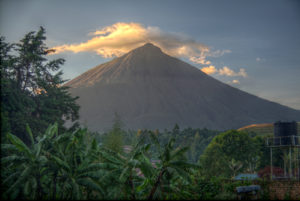 within the Virunga ranges. Mount Muhabura is very close to Mount Sabyinyo and Mount Gahinga. Muhabura means “the guide” in the local language. This name was coined probably because it was used as a guide by distant travelers.
within the Virunga ranges. Mount Muhabura is very close to Mount Sabyinyo and Mount Gahinga. Muhabura means “the guide” in the local language. This name was coined probably because it was used as a guide by distant travelers.
Mount Muhavura is characterized by a cone-like shape with volcanic ash and other related materials on the slopes and at the foot. The Volcanic ash supports the group of shrubs and thickets on the sides of the mountains. The Kabiranyuma river/swamp is another prominent feature that separates Mount Muhabura from Mount Gahinga. Mountain Muhabura offers opportunities to spot rare species of birds and mammals like buffaloes, elephants and Mountain gorillas – especially from the Uganda side. The buffaloes can be dangerous to hikers because they are naturally aggressive but armed rangers are always on hand to scare them away just in case. You might be interested in the page about climbing Mount Kilimanjaro.
Hiking Mount Muhabura
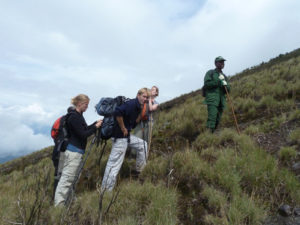 Mount Muhabura is the most difficult mountain to hike among the 8 volcanoes in the Virunga Ranges. It may not be the tallest but it is very steep and yet one is required to complete the hike in one day (before the sun sets). To reach the summit and descend on time, one needs to be mentally prepared and maybe a little stubborn. Hiking Mount Muhabura is arranged from both the Uganda and Rwanda side. If you are climbing mount Muhabura from the Uganda side, you will be met by the resident Guides from the Uganda Wildlife Authority and led to the Ntebeko visitors Centre. If hiking from the Rwanda side, you need to report to the Kinigi visitors centre from where you will pay for the activity (In case you made your own travel arrangements).
Mount Muhabura is the most difficult mountain to hike among the 8 volcanoes in the Virunga Ranges. It may not be the tallest but it is very steep and yet one is required to complete the hike in one day (before the sun sets). To reach the summit and descend on time, one needs to be mentally prepared and maybe a little stubborn. Hiking Mount Muhabura is arranged from both the Uganda and Rwanda side. If you are climbing mount Muhabura from the Uganda side, you will be met by the resident Guides from the Uganda Wildlife Authority and led to the Ntebeko visitors Centre. If hiking from the Rwanda side, you need to report to the Kinigi visitors centre from where you will pay for the activity (In case you made your own travel arrangements).
After paying at the offices, A Guide and Rangers will be assigned to your group who will lead you all the way up the mountain. If you are moving with heavy luggage or equipment, then Porters are available for hire at the foot of the mountain. In case the group is large, hikers are usually split into two – the slow hikers and seasoned/experienced hikers. If it gets too late and you haven’t reached close to the summit, you are simply advised to give up and descend along with others who completed in time.
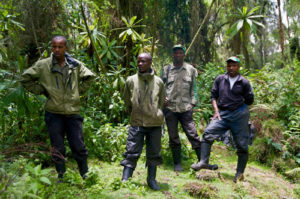 Climbing Mount Muhabura starts at around 7 am and takes between 5 to 7 hours to complete. Before heading off to the head trail, the Rangers will organize a briefing for all hikers. This briefing covers all important aspects of the hike and includes the history and formation of the mountain. The Rangers will advise hikers on how to prepare mentally for the activity and deal with any injuries or symptoms of altitude illness. During the briefing, the Rangers and Guides will also check to see if all hikers have the necessary gear hiking boots, walking sticks, packed lunch, the right clothing, packed lunch, drinking water and a walking stick. All supplies and equipment have to be sorted out before proceeding to the head trail.
Climbing Mount Muhabura starts at around 7 am and takes between 5 to 7 hours to complete. Before heading off to the head trail, the Rangers will organize a briefing for all hikers. This briefing covers all important aspects of the hike and includes the history and formation of the mountain. The Rangers will advise hikers on how to prepare mentally for the activity and deal with any injuries or symptoms of altitude illness. During the briefing, the Rangers and Guides will also check to see if all hikers have the necessary gear hiking boots, walking sticks, packed lunch, the right clothing, packed lunch, drinking water and a walking stick. All supplies and equipment have to be sorted out before proceeding to the head trail.
After the usual briefing, hikers are driven or taken to the starting point of the hike by the park authorities, their personal driver or a Guide/Driver from their Tour company. Hiking Mount Muhavura is very demanding because it is steep. One needs to be very fit in order to complete the hike. The cost of climbing Mount Muhabura is $75 per person in Uganda. This price excludes transportation, accommodation and hiring porters. You need to pay the porters separately. Permits for climbing Mount Muhavura can be got on the same day as the hike in both Uganda and Rwanda.
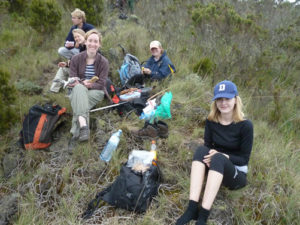 Hiking Mount Muhabura from the Uganda side involves two major stops before reaching the summit. The first stop is at about 3,117 meters above sea level while the second is at about 3,860 meters above sea level. A good number of hikers do not make it past the first stop (hut). They simply rest, take their lunch and decide that enough is enough before returning back to the starting point. Infact, in most large groups, less than 50 make it to the top. Those that continue have to endure a more difficult hike to reach the second hut (stop). After the second stop, the hike becomes even more challenging. But by this time, there is no turning back because the summit is so near. To continue from this point onward requires more stamina, determination and a certain level of fitness. It gets colder and the mountain is often covered with mist. Some might suffer from altitude sickness or injuries to their ankles at this point.
Hiking Mount Muhabura from the Uganda side involves two major stops before reaching the summit. The first stop is at about 3,117 meters above sea level while the second is at about 3,860 meters above sea level. A good number of hikers do not make it past the first stop (hut). They simply rest, take their lunch and decide that enough is enough before returning back to the starting point. Infact, in most large groups, less than 50 make it to the top. Those that continue have to endure a more difficult hike to reach the second hut (stop). After the second stop, the hike becomes even more challenging. But by this time, there is no turning back because the summit is so near. To continue from this point onward requires more stamina, determination and a certain level of fitness. It gets colder and the mountain is often covered with mist. Some might suffer from altitude sickness or injuries to their ankles at this point.
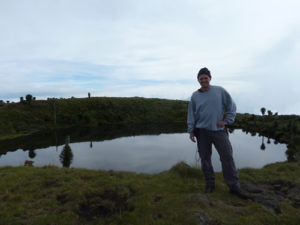 Those who make it all the way up to the top after such a challenging hike are rewarded with breathtaking scenery, the beautiful countryside, lakes and the other volcanoes within the Virunga ranges like Sabyinyo, Gahinga, Karisimbi, Bisoke and Nyiragongo. The summit gives you that feeling of being completely away from the real world. There are opportunities to spot primates, birds and even large forest mammals like buffaloes and Elephants. Then there is a crater lake at the summit with beautiful clear waters. Hikers can swim in the lake but most are discouraged because it is usually very cold. From the Rwanda side one can spot the beautiful twin lakes Ruhundo and Burera while Lake Bunyonyi can be seen from the Uganda side. Unfortunately cloud cover and mist may limit one’s view of the distant volcanoes during some months of the year.
Those who make it all the way up to the top after such a challenging hike are rewarded with breathtaking scenery, the beautiful countryside, lakes and the other volcanoes within the Virunga ranges like Sabyinyo, Gahinga, Karisimbi, Bisoke and Nyiragongo. The summit gives you that feeling of being completely away from the real world. There are opportunities to spot primates, birds and even large forest mammals like buffaloes and Elephants. Then there is a crater lake at the summit with beautiful clear waters. Hikers can swim in the lake but most are discouraged because it is usually very cold. From the Rwanda side one can spot the beautiful twin lakes Ruhundo and Burera while Lake Bunyonyi can be seen from the Uganda side. Unfortunately cloud cover and mist may limit one’s view of the distant volcanoes during some months of the year.
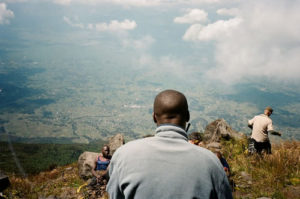 If the hikers were climbing at a slow pace, there will be little time to spend on top of the mountain. The Rangers will ask that you leave the summit early so as not to encounter forest mammals like buffalo or find yourself descending down in darkness. Before climbing down, a group photo with all participants is a requirement. Descending down the mountain is not easy. In fact, to some, it is just as challenging as climbing up. There are two reasons for this. It is very slippery going down and this second part finds when your body is fatigued from the climb. The legs and body joints would be in pain at this point and descending puts more pressure on the body joints. Moreover, even after reaching the foot of the mountain, you will still have to move through gardens and human settlements before getting back to the office or meeting your Driver/Guide.
If the hikers were climbing at a slow pace, there will be little time to spend on top of the mountain. The Rangers will ask that you leave the summit early so as not to encounter forest mammals like buffalo or find yourself descending down in darkness. Before climbing down, a group photo with all participants is a requirement. Descending down the mountain is not easy. In fact, to some, it is just as challenging as climbing up. There are two reasons for this. It is very slippery going down and this second part finds when your body is fatigued from the climb. The legs and body joints would be in pain at this point and descending puts more pressure on the body joints. Moreover, even after reaching the foot of the mountain, you will still have to move through gardens and human settlements before getting back to the office or meeting your Driver/Guide.
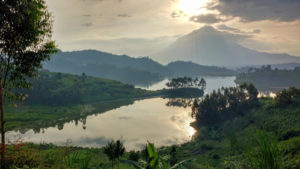 Note: Hiking Mount Muhavura is very challenging. Even the most seasoned hikers will not find it a walkover. To succeed in reaching all the way up to the summit, it is important to know your personal limits. Go according to your pace. Do not rush or use a lot of energy in the beginning. Drink plenty of water. Should you feel any pain or feel like giving up, stop and admire the beautiful scenery down for a few seconds to remind yourself of what you will behold once you reach the very top.
Note: Hiking Mount Muhavura is very challenging. Even the most seasoned hikers will not find it a walkover. To succeed in reaching all the way up to the summit, it is important to know your personal limits. Go according to your pace. Do not rush or use a lot of energy in the beginning. Drink plenty of water. Should you feel any pain or feel like giving up, stop and admire the beautiful scenery down for a few seconds to remind yourself of what you will behold once you reach the very top.
Climbing Mount Muhabura is best done alongside gorilla trekking in Mgahinga or the Volcanoes National Park in Rwanda. Apart from gorilla trekking, one can also visit the Beautiful Lake Mutanda in Uganda for a walk, track golden monkeys in Uganda or Rwanda or visit the Batwa pygmies in Uganda. In Rwanda, the best place to go for a cultural visit is at the Iby’iwacu cultural village.
How to reach Mount Muhabura
Mount Muhabura can easily be reached by car from both Uganda and Rwanda. From Kampala city in Uganda, one will need to drive for 8 hours to Kisoro through Kabale (510 Kilometers). Once you rich Kisoro, a taxi or local motorcycle can take you to the headquarters of Mgahinga National Park. If you are using public means or a motorcycle taxi (boda boda), please ensure that you keep the phone number and names of the divers/riders so that you can call them to pick you once you are done with climbing the mountain. There are few vehicles and motorcycles plying the route between Mgahinga National Park offices and Kisoro town especially in the evening hours. Those who drive themselves should be very keen on direction. Be on the lookout for sign posts showing the direction to the park you pass nearby trading centers or small towns. Ensure that the car you hire has GPS installed.
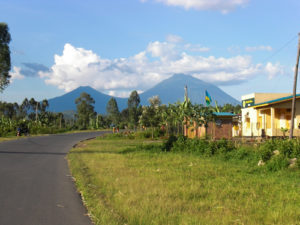 Those climbing Mount Muhabura Volcano from Rwanda simply connect to the Volcanoes National Park by road from Kigali in a journey that takes 3 hours. If your journey begins from Kigali in Rwanda, you need to begin your journey by 5am so that you reach the park in time for the briefing.
Those climbing Mount Muhabura Volcano from Rwanda simply connect to the Volcanoes National Park by road from Kigali in a journey that takes 3 hours. If your journey begins from Kigali in Rwanda, you need to begin your journey by 5am so that you reach the park in time for the briefing.
It is also possible to book a chartered flight from Entebbe in Uganda or Kigali in Rwanda up to the nearest airstrips to the national parks. In Uganda Aerolink has daily flights from Entebbe to an Airfield in Kisoro. Flights from Entebbe to Kisoro take 1 hour. A driver from your tour company can wait for you at the Airstrip in Kisoro and drive you to the park.
International travelers should book their hiking tour with a good tour company. Hiring a private car may be cheaper but you cannot guarantee the condition of the cars or be sure of getting to the right places and on time for your activity. Tour operators normally arrange for transportation, permits, accommodations and a Guide/Driver leaving you with a simple task of showing up. The Drivers from Tour companies are usually experienced and knowledgeable about the park and will share vital information about your hike. They know how to help you even when things get stuck somewhere.
Packing list for climbing Mount Muhabura
To have the best possible experience, hikers need to move with light snacks, drinking water, a walking stick, hiking boots, warm stockings, hand gloves, rain jackets, insect repellents and sunscreen. Good hiking shoes are very important for a Mount Muhabura hike especially during the wet season.
Apart from the above items, don’t forget to travel with a good camera, binoculars and full batteries. You will need the binoculars to have clearer views of the distant volcanoes and other landmarks. A good camera helps capture good photos to show your friends and family.


Lovely place. I am looking forward to coming for a hike in the near future.
I would like to hike Mount Muhabura in January. I am from Kampala Uganda.
I climbed to the summit in 2013 and it was beautiful. Would love to return one day!
I would like to go for the next dry season hiking period – preferably in 2023. What do I need to prepare for this and when is the the next hiking?
When is the best time to hike Mount Muhabura?
The best time to hike Mount Muhabura is during the dry season. The dry season occurs between June to early October and November to early March. Hiking activities occur all through the year but the dry season is recommended because the trails are less slippery. Mist is less and one can get clear views of the horizon and nearby volcanoes during the dry season.
It was fun. I failed to make it for the first time in 2018 but managed to reach the top in 2019.